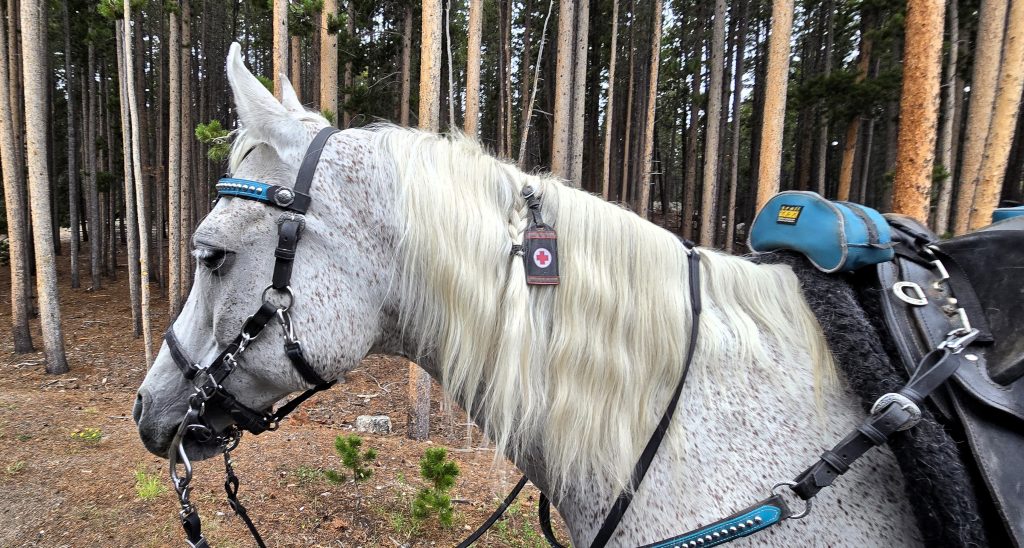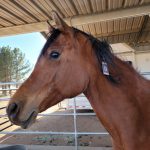I regularly see posts on Facebook from people inquiring about horse identification options. In my opinion, not nearly enough people are proactive about having identification on their horses. As a retired veterinarian, I am passionate about good animal husbandry practices. Therefore, I am always glad to see someone inquire about what types of identification are available to help ensure that your equine buddy can find his way back home.
For decades my dogs have worn collars with their name and my phone number embroidered on the collar. Several of them often trail ride with my husband and me. They are trained to stay close, but should they get separated from us, I know how easily I can be notified. Why would I not want to have the same protection on my horses?
My initial epiphany
I had been riding horses for 50 years before it dawned on me that I could make improvements to both my safety and the safety and security of my horse. I realized that should I have an accident on the trail, or become separated from my horse for any reason, no one would know who I was or where my horse belonged. If First Responders needed to treat me and I was unable to respond, would they know important medical information about me, or who to call in case of emergency? To fill this gap, I created the first version of ID MyHorse Emergency Information Tags.
Eventually, I came to realize that the tag I had created had significant value when it came to providing identification during natural disasters. ID MyHorse is now on the third-generation version of this tag, and we could not be happier about “how many boxes it checks” in terms of what it is designed to do. This latest version was developed with significant input from First Responders of all kinds… firemen, EMTs, and Animal Control officers among others.

Our original tag had “ID MyHorse” stamped on both sides. Initially, my husband and I wore the same tag on our person as we had braided into the manes of our horses. Both tags contained the same information… detailed content about the horse and the rider/owner. It was an EMT who requested the universally recognized RED CROSS symbol that immediately grabbed the attention of First Responders.
The second-generation tag had the RED CROSS symbol for RIDERS, but still had “ID MyHorse” on both sides of the horse tag. I thought “ID MyHorse” was self-explanatory, but the firefighters wanted the RED CROSS symbol as well. Once again, they stated that the RED CROSS symbol immediately “spoke” to them. They also requested reflective strips on the tag to aid in spotting the horse at night or in smoky conditions. The strips are identical to what is on the uniforms of the firefighters.
The latest, and likely last, iteration of this tag has incorporated this valuable input. This third-generation tag is smaller than the first two, weighing in at a mere .63 ounces.
What boxes does it check?

Let’s start by checking the boxes requested by the First Responders:
- Universally recognized RED CROSS symbol that alerts First Responders to critical information contained within
- Reflective strips to aid Firefighters in locating livestock at night or in smoky conditions
- Critical medical information about both horse and rider that aids in immediate and safe medical attention and management
Two years ago, I attended a clinic hosted by multiple agencies that dealt with a massive livestock evacuation incident due to the Marshall Fire in Colorado. At the end of this post, I will share a video I made describing a portion of what these front-line responders had to say. They had some definite ideas about what they would like to see already on a horse that might end up at a collection point.
- Made of a material that won’t burn or melt in a fire… leather was recommended
- Something already on the horse when it arrived at the evacuation facility
- Preferably not attached to a halter which will likely be removed
- Identification that will stay on for an extended period of time
- Readily visible
- Poses no danger to the horse
What horse identification options are out there?
MICROCHIPS
One of the responses I hear most often when discussing ID with horse owners is, “My horse is microchipped.” I have written several blog posts about microchipping horses. Microchips are a wonderful tool, but they have some serious limitations in certain situations. In my opinion, they are best used when proving that the horse you are competing on in an elite competition is truly the one you entered. They are wonderful when it comes to proving that the horse stolen from you and happily recovered is truly your horse.
They have far less value when your horse is one of hundreds at a collection facility. A microchip won’t do you much good if your horse is lost in the wilderness and is found by a hiker. Your horse’s microchip won’t tell anyone caring for your horse in your absence that he has Cushing’s Disease or is allergic to Banamine.
Less than 1-2% of horses are microchipped in this country. (Surprisingly, only about 4% of small animals are chipped, a figure which shocked me!) There are two different wands required to detect the multiple different types of chips. There are so many types of chips that there is a database of databases! A hiker finding your horse in the woods will have no use for a microchip.
If your horse is one of hundreds at a collection point, is it realistic to expect rescuers to wand hundreds of horses, write down a 10-15 digit alphanumeric number, match it with a horse description and stall location, and then go back and look it up? Is the chip still where it was placed and where it is supposed to be? Did you register the chip? Is your information up to date? Are they going to wand all those horses looking for the 1-2% who might have a chip?
IF your horse has readily visible ID and an easy-to-access phone number for you, then you can prove that is your horse when you show up with your microchip paperwork. But you have to be called first…
FETLOCK BANDS
Fetlock bands are typically made out of nylon, which melts. A horse moving over hot embers is going to have molten nylon on their fetlock joint. They require 32# of pressure to break the quick-release buckle. In my opinion, that is a lot of torque on delicate joints. They provide only a phone number. Any rip, mark or melting of the band might make that number impossible to read.
BROODMARE BANDS

Broodmare bands are very similar to fetlock bands. They are also made of plastic or nylon. They usually have a quick-release buckle. They only provide room for a phone number. It is debatable in my mind whether a broodmare band or a fetlock band is most likely to get caught on something. If it gets caught and comes off, you have no ID. If it gets caught and doesn’t come off, you have a potential problem.
CLIP ON PEN-TYPE ID
There is a type of ID that looks something like a ballpoint pen that clips onto the mane. One such product states (in bold letters) that it is not designed for everyday use. My husband and I were just evacuated from a wildfire on our mountain. We were boating and camping 45 minutes away when our neighbor called to tell us our mountain community was under mandatory evacuation. We got our horses off the mountain 45 minutes before the access road was closed to trailers. If our horses were not already wearing ID tags, they might have had to be turned loose without identification at all. Unless you plan to be camped next to your horse 24/7, depending on something you have to add at the last minute might not be a good plan.
PAINTING THE BODY OR HOOF
Speaking of being camped next to your horse 24/7, this is also a very last-minute plan. The neighbors who were watching our horses while we camped are quite capable of feeding them and watching for signs of illness. But to expect them to write my phone number (which they will have to look up) on my horses is totally unrealistic. Where is the paint? How much time are they going to waste messing around with my horses when they need to get off the mountain?
I have a friend who told me that she wrote on a hoof with a Sharpie and painted her horse’s body on a normal day just to see how long it lasted. It didn’t… She said, “I used a black marker on the hoof. They wiped it off in a couple of hours in the dusty corral. Body paint was a mess. I think that it was too thick or too thin.” One gal told me she used something in her husband’s shop and it lasted a week… but good luck finding the right kind of paint at the literal last minute.
AIRTAGS, GPS OPTIONS
I have a good horse friend who told me once, “If I only knew when my dog was going to run away, I’d be sure to have his GPS collar charged!” I have extensively researched the possibility of putting some kind of GPS chip in ID MyHorse tags. There is nothing currently available that would have a long enough battery life to make it feasible.
The leather pouch design of our tags would make it very easy to slip a chip inside. However, one of the best features of our tags is that you can braid them in the mane and leave them. Repeatedly having to remove a chip to charge it would be a challenge. We have a microphone system on our helmets, and we struggle to bring those into the house to charge them. Sometimes relying on an old-school approach is still the best thing.
I often see people inquiring about using AirTags. A quick Google search will tell you that under optimal conditions, AirTags might have a range of 800 feet. Most of the Google responses indicated more along the lines of 30-100 feet. Again, lost in the wilderness would not be what I call optimal conditions.
Some final thoughts

Getting used to having our horses wear ID tags around the clock was much like getting used to wearing my seatbelt when I was in my 20s. I had to be told several times by several people who cared about me and my safety that I really should be wearing my seatbelt. Finally, it sunk in. Now, I can’t imagine driving without it.
It is the same with the tags. Even before we were evacuated a few weeks ago, I took great comfort in knowing that the horses could safely find their way home if we were separated. In my post about our evacuation, I described the incredible sense of relief my husband and I felt when we rounded the corner of the reservoir, still in the boat, and saw that awful plume of smoke right where our home was located. We knew that if our neighbors had to turn our horses loose, we could get them back easily.
I have already stated that our horses wear their tags all day every day. We don’t have to be sleeping in their stalls. They stay for months at a time, and I only rebraid when they have dropped down a bit or the braid is messy. This video shows how I attach them. They contain folded-over paper that provides a wealth of information about both horse and rider. The paper is enclosed in plastic which is then enclosed in fire-proof leather. They weigh .63 ounces, less than the mane clip type. They are safe, as the worst that could happen is they rip out some mane. They are less likely to catch on something and not likely to harm the horse if they do.
When I have a conversation with people about using horse identification, my main mantra is to at least have a plan. This post talks about general emergency preparedness. And yes, I want you to think about having identification on your horse. I have done the research about the pros and cons of other options. My choice might not be your choice, but make a plan of some type!
There was a story on Facebook recently about a horse lost in the woods for 5-6 days. The horse was caught by a couple of hikers. Because they were not horse people, and because they had no clue what to do with the horse, they turned it loose again! They did call the park office, who notified the owner. After more searching, she found her horse. But wouldn’t it have been much easier if even non-horsey people recognized a RED CROSS tag with ID MyHorse stamped on the other side and were able to call the owner directly?
MAKE A PLAN!










